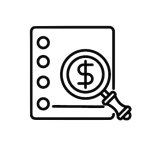 Here is a summary of the most important tips and suggestions we have compiled to help you on your journey. Take a few minutes to explore each topic to make sure you are on the road to a happy retirement.
Here is a summary of the most important tips and suggestions we have compiled to help you on your journey. Take a few minutes to explore each topic to make sure you are on the road to a happy retirement.
 Create a Budget
Create a Budget
Take an honest look at your entire financial situation — what you own and what you owe. This is a “net worth statement.” On one side, list what you own. These are your “assets. ” On the other side, list what you owe. These are your “liabilities” or debts. Subtract your liabilities from your assets. If your assets are larger than your liabilities, you have a “positive” net worth. If your liabilities are larger than your assets, you have a “negative” net worth.
You’ll want to update your “net worth statement” every year to keep track of how you are doing. Don’t be discouraged if you have a negative net worth — following a financial plan will help you turn it into positive net worth.
The next step is to keep track of your income and expenses. Write down what you and others in your family earn and spend each month, and include a category for savings and investing. If you are spending all your income, and never have money to save or invest, start by cutting back on expenses. When you watch where you spend your money, you will be surprised how small everyday expenses can add up. Many people get into the habit of saving and investing by paying themselves first. An easy way to do this is to have your bank automatically deposit money from your paycheck into a savings or investment account.
Here are some tools to help you build a personal budget:
CreditKarma Monthly Budget Templates
 Build A Basic Financial Plan
Build A Basic Financial Plan
Knowing how to secure your financial well-being is one of the most important things you can do for yourself. You don’t have to be a genius to do it. You just need to know a few basics, form a plan, and be ready to stick to it. To end up where you want to be, you need a financial plan. Ask yourself what you want. List your most important goals first. Decide how many years you have to meet each specific goal, because when you save or invest, you’ll need to find an option that fits your time frame.
Here are some tools to help you decide how much you’ll need to save for retirement:
FINRA Retirement Calculator
Nerdwallet Retirement Calculator
Use this tool to see if you are on track for retierment with your current savings:
Retirement Calculator

 Save for Retirement
Save for Retirement
Employer-sponsored retirement plans can be a great source of income when you retire, and if your employer offers matching funds, it is like getting free money. Retirement plans generally fall into two categories: defined benefit plans and defined contribution plans.
A defined benefit plan, also known as a pension plan, promises you a specified monthly benefit at retirement. These type of plans used to be very common but are now not a very common offering. The benefit may be a fixed dollar amount or may depend on a plan formula that considers factors such as salary and years of service. Employers sponsor defined benefit plans and typically hire investment managers to make investment choices. The employer shoulders the investment risks.
A defined contribution plan, such as a traditional 401(k) plan, does not promise you a specific payment upon retirement. In these plans, you or your employer (or both) contribute to your individual account under the plan, sometimes at a set rate, such as 5% of your annual salary. Employee contributions to a 401(k) plan and any earnings from the investments are tax-deferred. You pay the taxes on contributions and earnings when the savings are withdrawn. As a benefit to employees, some employers will match a portion of an employee’s 401(k) contributions. It is wise to contribute at least enough to receive the full employer matching contribution, so you full advantage of the additional savings. Income taxes on matching funds also are deferred until savings are withdrawn. These plans give employees a choice of investment options they can choose from to build a portfolio.
An employer-sponsored Roth 401(k) plan is similar to a traditional plan with one major exception. Contributions by employees are not tax-deferred but are made with after-tax dollars. Income earned on the account, from interest, dividends, or capital gains, is tax-free. In a defined contribution plan, the employee shoulders the investment risks, and the value of the account will fluctuate due to changes in the value of the investments. Upon retirement, you receive the balance in your account, which depends on contributions plus or minus investment gains or losses.
 Gauge Your Risk Tolerance
Gauge Your Risk Tolerance
What are the best saving and investment products for you? The answer depends on when you will need the money, your goals, and whether you will be able to sleep at night if you purchase a risky investment (one where you could lose your principal).
For instance, if you are saving for retirement, and you have 35 years before you retire, you may want to consider riskier investment products, knowing that if you stick to only the “savings” products or to less risky investment products, your money will grow too slowly. Or, given inflation and taxes, you may lose the purchasing power of your money.
A frequent mistake people make is putting money they will not need for a very long time in investments that pay a low amount of interest.
On the other hand, if you are saving for a short-term goal, five years or less, you don’t want to choose risky investments, because when it’s time to sell, you may have to take a loss.
 Diversify Your Investments
Diversify Your Investments
Diversification is a strategy that can be neatly summed up as “Don’t put all your eggs in one basket.” The idea is that if one investment loses money, the other investments will make up for those losses. Diversification can’t guarantee that your investments won’t suffer if the market drops. But it can improve the chances that you won’t lose money, or that if you do, it won’t be as much as if you weren’t diversified.
One way to diversify is to allocate your investments among different kinds of assets. Historically, stocks, bonds, and cash have not moved up and down at the same time. Factors that may cause one asset class to perform poorly may improve returns for another asset class. People invest in various asset classes in the hope that if one is losing money, the others make up for those losses.
You’ll also be better diversified if you spread your investments within each asset class. That means holding a number of different stocks or bonds, and investing in different industry sectors, such as consumer goods, health care, and technology. That way, if one sector is doing poorly, you may offset it with other holdings in sectors that are doing well.
 Start Emergency Fund for a Rainy Day
Start Emergency Fund for a Rainy Day
Most smart investors put enough money in savings to cover an emergency, like sudden unemployment. Some make sure they have up to six months of their income in savings so that they know it will absolutely be there for them when they need it.
But how “safe” is a savings account if the interest it earns doesn’t keep up with inflation? Let’s say you save a dollar when it can buy a loaf of bread. But years later when you withdraw that dollar plus the interest you earned, it might only be able to buy half a loaf. That is why many people put some of their money in savings, but look to investing so they can earn more over longer periods of time.
 Plan for College Expenses
Plan for College Expenses
College can be one of the most expensive items you ever pay for, so it makes sense to plan for plan for such a large event.
Here are some tools to help you determine how much college may cost and how much you should save to pay for it:
SEC College Savings Calculator
FIRNA Education Savings Calcualtor
College Savings 101 from SavingForCollege.com
Other Useful Sites:
https://www.finra.org/investors/tools-and-calculators
https://www.investor.gov/free-financial-planning-tools
https://www.mymoney.gov/
 Diversify Your Investments
Diversify Your Investments

 Here is a summary of the most important tips and suggestions we have compiled to help you on your journey. Take a few minutes to explore each topic to make sure you are on the road to a happy retirement.
Here is a summary of the most important tips and suggestions we have compiled to help you on your journey. Take a few minutes to explore each topic to make sure you are on the road to a happy retirement. Create a Budget
Create a Budget Build A Basic Financial Plan
Build A Basic Financial Plan
 Save for Retirement
Save for Retirement Gauge Your Risk Tolerance
Gauge Your Risk Tolerance Start Emergency Fund for a Rainy Day
Start Emergency Fund for a Rainy Day Plan for College Expenses
Plan for College Expenses